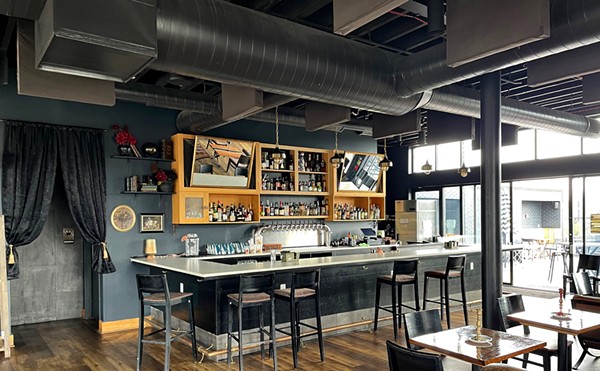Like those requisite stick figure magnets on the back of every minivan, barrel-aged cocktails have become so common, so fast, that it's difficult to remember a time when they weren't around. Today, there are upwards of 30 bars and restaurants with barrel-aging programs in Cleveland. Prior to this year, you could count the number on one hand.
"Barrel aging is a point of differentiation in a crowded market," notes Ryan Grammerstorf, assistant GM at Cowell & Hubbard. "It's something new for consumers and it's a chance for bartenders to express themselves." Indeed, but bartenders can also express themselves with a natty vest and well-waxed handlebar mustache. So, what's the big deal?
Two Motivations
The key ingredient in Cowell & Hubbard's take on the Manhattan, the Bacon Man, isn't the bacon fat-washed Bulleit Rye, or the maple syrup, or the bitters, or even the Carpano Antiqua sweet vermouth. No, it's the time spent in a charred American oak barrel. Further east at the Grovewood Tavern in Collinwood, Tadas Gelazis has had a barrel-aged Negroni sitting in an 8-liter oak barrel for two months. Consisting of equal parts Tanqueray Rangpur gin, Campari and Dolin Rouge sweet vermouth, the barrel-aged Negroni should make its debut at the bar any day now. "There are two motivations behind introducing a cocktail to oak," Gelazis explains. "Some cocktails, like the Negroni, have ingredients which have not previously been barrel-aged. Putting them in a barrel introduces vanilla and caramel notes that help to mellow out their astringency."
"But you might also want to take ingredients which have already spent time in a barrel and give them a chance to meld," Gelazis adds. "Think of it like chili: You can eat it right away, but it always tastes better on the second day." Or the third day, or the fourth, or the 60th, in the case of some of these barrel-aged beverages. A cocktail is done aging when the ingredients integrate harmoniously and the oak is no longer a distinct flavor.
"Barrel aging is a way for bartenders to create flavors that you can't otherwise get in a mixing glass," Gelazis says.
Cross-Pollination
Though it's common practice to use a given barrel repeatedly for a given cocktail, that's not always the case at the Greenhouse Tavern, where a previous cocktail is sometimes considered an ingredient in the one that follows, thanks to a certain amount that gets trapped in the wood. "We have a hot toddy made with dark rum and Barenjager honey liqueur that we age in an old vin chaud barrel," says beverage director Erin Lowe. "We put so many mulling spices in there initially that everything we've put in since takes on that same characteristic. I don't have to add any additional spices or infuse any liquor because the barrel's already doing that for me." The Greenhouse put barrel-aged cocktails on its menu at a time when many Cleveland restaurants were still calling all mixed drinks "martinis." Consequently, their offerings are some of the most mature and varied on the market. The most inventive of the bunch is a barrel-aged Aperol Spritz, made from Bluecoat gin, Aperol and Cocchi Americano — aged in oak, run through a tap system for carbonation and topped off with Prosecco.
Safety First
One person responsible for the current barrel-aging boom in Cleveland is actually from St. Louis. Matt Seiter is bar manager at Sanctuaria Wild Tapas and author of Sanctuaria: The Dive Bar of Cocktail Bars. In late September, he was flown in to speak before the Cleveland chapter of the United States Bartenders Guild (USBG). Though everyone in attendance left his demonstration with a barrel, much of Seiter's talk centered around what not to put in it. "The logic is very simple," he explained. "If you can put something on your back bar in the open air for a week and it doesn't spoil, you can put it into a barrel." That includes bitters, liqueurs, and hard liquor, but excludes fresh fruit juice and any combination of ingredients that has not been fortified above and beyond 17.6 percent ABV, past which Seiter says it is considered shelf stable. Best practices are doubly important because barrel-aged cocktails are, by the letter of the law, illegal. The Alcohol and Tobacco Tax and Trade Bureau requires any spirit be served immediately when dispensed from its original container — a law that is not enforced in practice — while Ohio's health department requires that containers with pre-mixed beverages must be emptied and cleaned every two weeks. In practice, these same laws make every slushy machine margarita in Ohio illegal and are seldom enforced.
Good bartenders know that if they do right by their guests and don't get them sick, they'll have little to worry about. "The last thing we want is for some asshole to put cream in a barrel," said one USBG member.









